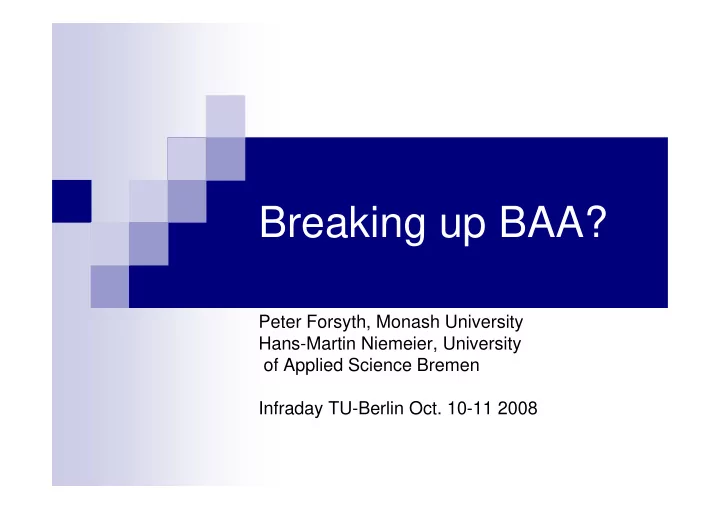

Breaking up BAA? Peter Forsyth, Monash University Hans-Martin Niemeier, University of Applied Science Bremen Infraday TU-Berlin Oct. 10-11 2008
Key Issues UK Competition Commission recommends the break up of BAA. � Does separation increase competition so much that regulation is not necessary? � If regulation is still necessary, how effective is separation in promoting competition? � Will it improve efficiency if competition is weak?
Outline � Background on BAA � Efficiency and Ownership of the London Airports � Separation and Competition under Deregulation � Separation and Competition under Regulation � Conclusions
Background UK government announces privatization 1985 Starkie & Thompson recommends break up 1985 1987 Airports Act announces sale of BAA as a single entity OFT inquires if market structure works well for the 2006 consumer 2006 Ferrovial buys BAA Competition Commission recommends break up of 2008 BAA. BAA offers London Gatwick for sale. � Performance of BAA seen as very poor � Airport Crises: What can be done? Break up BAA
Efficiency and Ownership of the London Airports � Efficiency and Distributional Aspects � Price levels. No deadweight loss as charges are below market clearing levels � Congestion and Slot Availability. Problem, but separate issue. � Service Quality. Important issue. � Productive Efficiency. Some inefficiencies � Price Structures and Capacity Utilisation. Inefficient � Optimisation of Commercial Revenues. Single till
Efficiency and Ownership of the London Airports � Efficiency and Distributional Aspects (cont.) � Investment and Provision of Capacity. Environmental and planning restraints. � Slot Allocation and Rents. No extensive secondary trading and risks of inefficient use � Distributional Aspects. Rents accrue to airlines � Ownership and Incentives � BAA has behaved not as a profit- maximizer indicated by cross-subsidization of Stansted � Ferrovial might change this
Separation and Competition under Deregulation � Oligopolistic Market � Short run: � Excess demand at Heathrow and Gatwick � Charges above market clearing level with price discrimination � Possibility of productive inefficiency
Separation and Competition under Deregulation � Oligopolistic Market � Long run: � Suboptimal Investment � No threat of entry Most probably tacitly collude with high prices and profits. � � Small deadweight loss: high prices, but price discrimination � X-Inefficiency a possibility � Prices high - Would government allow substantial rent shifting? Passenger and airlines lose, airports win.
Separation and Competition under Regulation � Incentives to compete and keep costs down depend on availability of capacity and form of regulation. � Investment incentives depend on the form of regulation. � Price cap versus cost based regulation versus hybrid forms � Assume fairly pure price caps � May lead to changes in regulation – less prescriptive? � Conditional triggers would not work well under competition
Core Problems for Competition � Heathrow completely full – no spare capacity � Gatwick nearly full – especially at peaks � To compete (on price and quality) airport needs to be able to handle more output � Little scope in short run � Some scope in long run IFF allowed to make investments freely
Separation and Competition under Regulation � Competition through Price Structures in the Short Run � Some gains by increasing the number of passengers per aircraft � More passengers for the same runway capacity � Need adequate terminal capacity – probably so now � No Scope for Price Competition � Weak Quality Competition � Option for yard stick regulation already present
Separation and Competition under Regulation: Price and Quality D Price, C ost D 2 1 D 4 D 3 P c 2 c 1 0 x x Output 1 2
Capacity, Investment and Incentives � Can compete in long run if capacity is variable � Extend capacity under regulation: can gain more output and profit from � market expansion � from competitors output � But how flexible is capacity?
Determinants of Capacity Investment � Who determines what airport investments are next? � Planning inquires, regulators, airports, government? � Ideally public bodies should recognize externalities and regulate effectively � Indivisibilities mean all airports are not likely to have spare capacity all the time, reducing ability to compete � Capacity in reality is likely to lag behind demand � Implies only moderate scope for competition even in the long run
Conclusions � Separation with deregulation leads to a tight oligopoly market with price discrimination. � Efficiency high, but very high airport prices and profits � An unlikely policy option � Separation with price cap regulation is unlikely to lead to much competition: � Short run: Some competition in price structures. � Price competition is unlikely under price caps, even in long run; � Weak quality competition, but incentives slightly stronger; � Stronger incentive to invest in additional capacity, but major influence of regulation and government policy .
Conclusions � Separation is not the magic bullet. Limited contribution. � Regulatory reform to improve performance will be essential. Thank you !
Recommend
More recommend